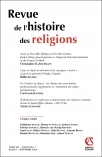
Revue de l'histoire des religions (1/2011)
Pour acheter ce numéro, contactez-nous
Recevez les numéros de l'année en cours et accédez à l'intégralité des articles en ligne.
À plusieurs reprises, au cours des rituels prescrits par les Tables Eugubines, l’officiant frappe le sol de son pas, selon une cadence ternaire et en un mouvement circulaire, ce que d’aucuns qualifient de « danse », par analogie avec les figures chorégraphiques des Saliens et des Arvales. Contrairement à ces exemples romains, le martèlement ombrien n’a aucune visée esthétique : Il a pour fonction rituelle essentielle, comme la libation à laquelle il est systématiquement associé, de faciliter (et d’apaiser) la communication avec des dieux ambivalents et inquiétants, aux ramifications sou terraines.
On several occasions, during the rites prescribed by the bronze Tables of Gubbio, the priest beats the ground with his step, following a ternary rhythm and performing a turning movement, which some have called a “dance”, comparatively to the choreographic figures of the Salians and the Arvals. Contrary to these Roman examples, the Umbrians’ hammering has no aesthetic aim : its main ritual function, as the libation to which it is systematically joined, consists in facilitating (and rendering peaceful) communication with ambivalent and disturbing gods with under ground ramifications.

